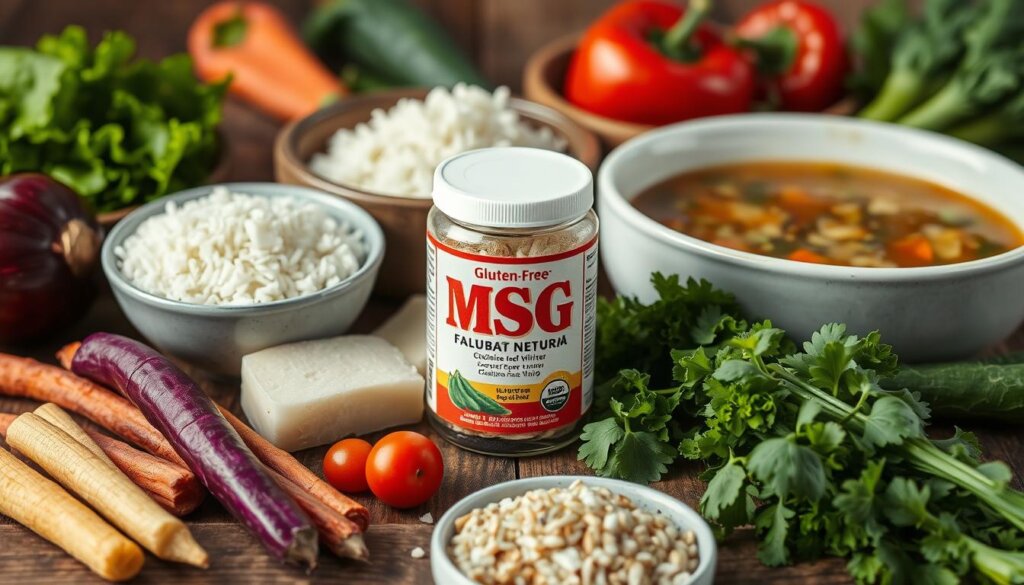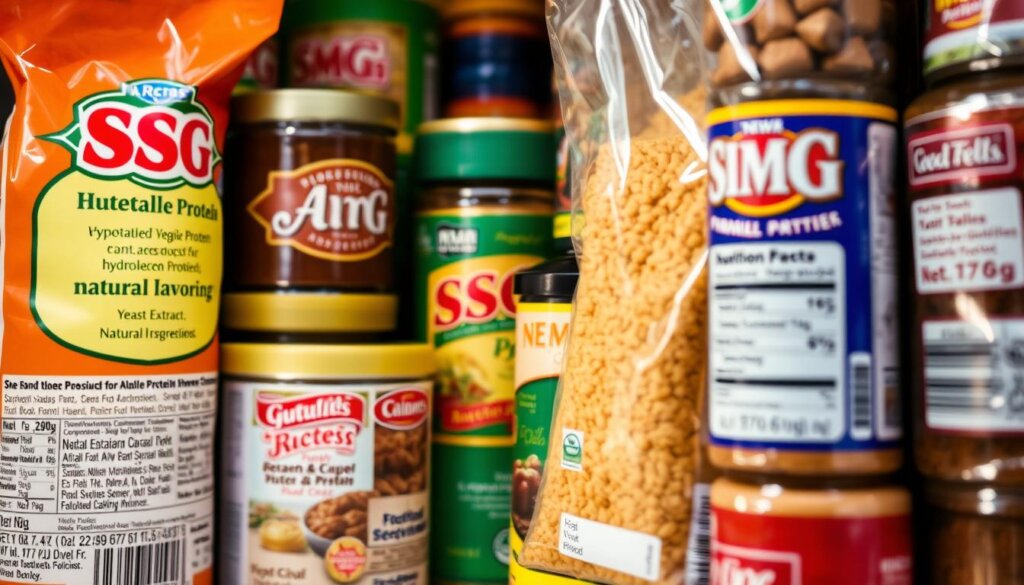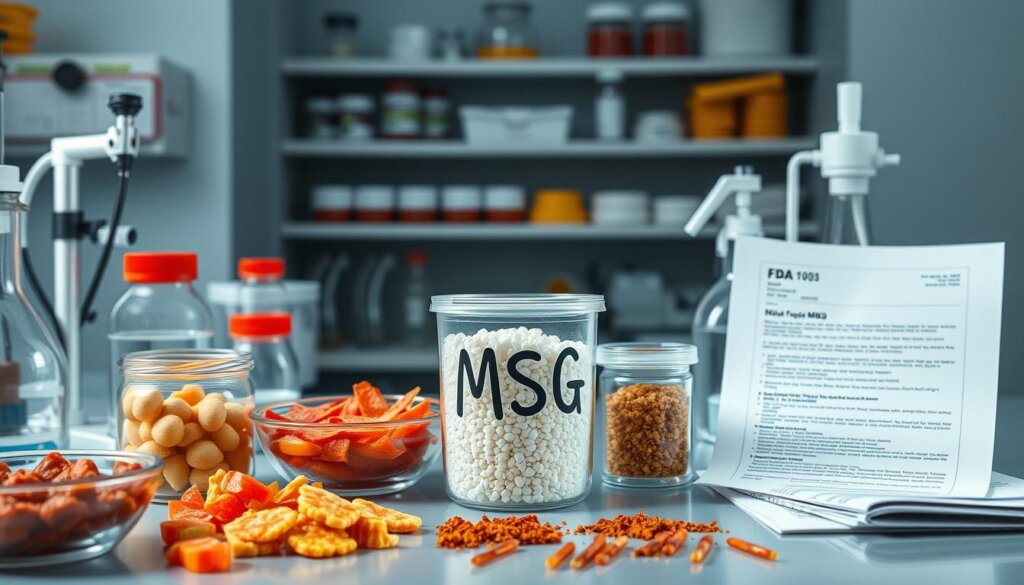Ever thought about monosodium glutamate (MSG), the flavor booster? It’s crucial to know if MSG is gluten-free, especially for those with celiac disease or following a gluten-free diet. This article will help you uncover the truth about MSG and gluten.
MSG, known for its rich umami taste, is listed as gluten-free by Celiac.com, but some individuals report adverse reactions. Understanding how MSG is made, its connection to gluten, and its potential health effects is vital for making informed dietary choices. Dive deeper into safe eating with our guides on gluten-free sauces like teriyaki, choosing the best gluten-free seasonings, and common hidden gluten sources in foods.
Table of contents
Understanding Mono-sodium Glutamate (MSG)
Monosodium glutamate, or MSG, is a flavor enhancer in many foods. It’s found in dishes worldwide, making them taste better. MSG is made from glutamic acid, which is in our bodies and some foods.
What is MSG?
MSG is the sodium salt of glutamic acid. Moreover, it’s known for its savory taste, often referred to as “umami.” Additionally, you’ll find it in snacks, fast food, and sauces, enhancing the richness of flavors in these foods.
How is MSG Produced?
MSG production started in 1909. It was first made from seaweed broth. Now, it’s made through fermentation of starches or sugars. This method uses sugar cane, molasses, or sugar beets.
MSG is absorbed in the small intestine. It moves into your bloodstream easily. Then, it makes food taste better by binding to taste receptors in your brain.
MSG is very good at making food taste better.
Is Mono-Sodium Glutamate Gluten-Free?
It’s important to know if monosodium glutamate (MSG) is safe for those with dietary limits. You might be wondering if MSG is okay for you, if you have celiac disease or gluten intolerance. The good news is that MSG is gluten-free, backed by strong scientific evidence.
Scientific Consensus on Mono-Sodium Glutamate and Gluten
Studies prove that MSG, a flavor booster, doesn’t contain gluten. Moreover, it is made from sodium and glutamate. Additionally, the production process of MSG involves fermentation, often using corn, which means no gluten is involved.
This makes MSG safe for those with gluten allergies.
Safety for People with Celiac Disease
Experts say MSG is safe for those with celiac disease and food allergies. Places like Celiac.com say MSG is gluten-free. So, if you have celiac disease, MSG is okay for you. It won’t harm your health.

What You Need to Know About Mono-Sodium Glutamate and Your Diet
Learning about MSG can help you choose better food. Some people think MSG is safe, but others have bad reactions. It’s key to know both good and bad effects of MSG.
Potential Reactions to Mono-Sodium Glutamate
Some folks get adverse effects of MSG like headaches or numbness. These reactions differ from person to person. They might be linked to food sensitivities.
Not everyone reacts the same way. How bad the reaction is depends on how much MSG you eat and your body’s sensitivity.
Understanding Adverse Effects
The FDA says MSG is safe to eat. But, eating too much MSG can cause problems. Symptoms can show up after eating more than 3 grams of MSG.
Most foods with MSG don’t have this much. Eating balanced meals can help avoid these issues. This way, you can enjoy food without worrying about MSG’s effects.
Hidden Names for MSG in Food Products
Reading food labels can be hard, mainly when you want to avoid MSG. MSG is hidden under many names in food. Knowing these names helps keep you healthy and in control of what you eat.
Common Label Terms for MSG
Food labels use tricky names for MSG, making it hard to spot in processed foods. Here are some names to look out for:
- Glutamic acid
- Hydrolyzed protein
- Yeast extract
- Natural flavors
- Caramel color
- Autolyzed yeast
- Modified food starch
- Monosodium glutamate (E621)
Ingredients that May Contain Mono-Sodium Glutamate
Being careful isn’t just about looking for MSG names. Some ingredients often have hidden MSG, which can be a problem for some people. Here are some ingredients that might have MSG:
| Ingredient | Potential MSG Content |
|---|---|
| Hydrolyzed vegetable protein | Often contains MSG |
| Sodium caseinate | Can contain glutamate |
| Calcium glutamate | Contains MSG |
| Malt extract | May contain MSG |
| Maltodextrin | Can generate MSG during processing |
| Natural flavors | May contain hidden MSG |

Is Sodium Glutamate Gluten Free?
It’s important to know if sodium glutamate, or MSG, is safe for those who follow a gluten-free diet. Additionally, MSG is made from glutamic acid and has been questioned about its gluten content. Therefore, knowing the truth about MSG can help those who are careful about what they eat.
Clarifying Misconceptions
MSG does not have gluten, so it’s okay for those who need to avoid it. Glutamic acid is found naturally in foods like tomatoes, cheese, and soy sauce. MSG used to be made from wheat, but now it’s made from sugar beets, sugar cane, molasses, or corn starch.
This change has made MSG safe for people with celiac disease, according to the FDA.
Cross-Contamination Concerns
Even though MSG itself is gluten-free, there’s a risk of cross-contamination. It might be made near products that have gluten, which is a problem for those with celiac disease. To stay safe, always check the labels and make sure the product is made in a gluten-free place.
| Aspect | Sodium Glutamate | Cross-Contamination Risk |
|---|---|---|
| Gluten Content | None | Possible |
| Regulatory Approval | FDA and EFSA Verified | Depends on Manufacturer |
| Natural Sources | Tomatoes, Cheese, Soy Sauce | N/A |
| Production Ingredients | Sugar Beets, Cane, Corn Starch | May Include Wheat Products |
By paying attention to food safety and checking labels carefully, you can enjoy MSG without breaking your gluten-free diet.
FDA’s Stance on MSG
The U.S. Food and Drug Administration (FDA) classifies monosodium glutamate (MSG), which influences how people perceive its safety. Additionally, understanding this classification can help you make more informed food choices.
Regulatory Classification of MSG
The FDA says MSG is generally recognized as safe (GRAS). This means it’s okay to eat. MSG must be labeled clearly on food. Some people might feel headaches or flush after eating it.
Research Findings and Safety Measures
Some studies show a few people might react to MSG. But, most research doesn’t link MSG to serious health issues. The safety of MSG is debated. Animal studies show problems at high doses, but it’s not clear if this applies to humans.

To avoid reactions, just skip foods with MSG. Glutamate, MSG’s main part, is in many foods but has less sodium than salt. Knowing this helps you choose wisely about MSG in your diet.
| Aspect | Details |
|---|---|
| FDA Classification | Generally Recognized as Safe (GRAS) |
| Labeling Requirement | Must be clearly listed on food products |
| Reported Reactions | Headaches, flushing, sweating, etc. |
| Population Sensitivity | Less than 2% report symptoms |
| Sodium Content | 12% sodium, lower than table salt |
Cooking with MSG: Considerations
Adding monosodium glutamate (MSG) to your cooking can make a big difference. Moreover, it can enhance the flavor of your food significantly. Additionally, knowing how to use MSG correctly allows you to enjoy its benefits while exploring new and exciting flavors.
How to Use MSG in Your Cooking
When using MSG, remember to use it sparingly. A small amount can make a big impact on taste. MSG works well in:
- Soups and stews
- Marinades
- Savory sauces
- Seasoned vegetables
Just 0.25 teaspoons of MSG can add four calories. This makes it a good way to add flavor without extra calories or fat.
Choosing MSG-Free Alternatives
If you don’t want to use MSG, there are other options. You can try:
- Fresh herbs like basil and parsley
- Spices such as cumin and paprika
- Umami-rich ingredients like tomatoes, mushrooms, and Parmesan cheese
These alternatives not only taste great but are also good for you. They make your food healthy and tasty. Trying these options lets you enjoy MSG’s benefits while staying true to your dietary choices.
Conclusion
MSG is safe for most people to eat. The FDA says it’s okay. It makes food taste better without big health risks.
But, some people might react to it. This can happen if they eat too much without food. So, it’s good to be careful.
Knowing about MSG helps you make better food choices. You can pick what’s best for you. This includes choosing MSG-free foods if you prefer.
With this knowledge, you can enjoy tasty meals. And you can do it while keeping your health in mind.
FAQ
Is mono-sodium glutamate (MSG) gluten-free?
Yes, MSG is gluten-free. It’s made by breaking down wheat proteins. This removes any gluten.
Can individuals with celiac disease safely consume MSG?
Yes, MSG is safe for those with celiac disease. Health sites like Celiac.com say it’s okay.
What are the possible reactions to MSG?
Some people might get headaches or chest pain. But these aren’t common. They could be due to personal sensitivities.
How can I identify MSG in food products?
MSG is listed under different names. Look for glutamic acid, hydrolyzed protein, yeast extract, and natural flavors.
What should I watch out for regarding cross-contamination with MSG?
MSG itself is gluten-free. But it might get mixed with gluten if processed together. Always check where it’s made.
What is the FDA’s stance on the safety of MSG?
The FDA says MSG is safe. They call it “generally recognized as safe” (GRAS).
How can I enhance flavors without MSG?
Use herbs, spices, mushrooms, tomatoes, or aged cheeses. They add umami without MSG.
Are there any specific health concerns related to MSG consumption?
Most people can eat MSG without issues. But some might feel bad from too much. Eat it in small amounts.
What is sodium glutamate in Chinese food?
Sodium glutamate, commonly known as MSG (monosodium glutamate), is a flavor enhancer used in Chinese food and other cuisines to enhance savory taste.
Can you be allergic to sodium glutamate?
While not an allergen, some people may have sensitivities to MSG, experiencing symptoms like headaches or nausea, often referred to as “MSG symptom complex.”
Is glutamic acid safe for celiacs?
Yes, glutamic acid and MSG are gluten-free and safe for celiacs as they are not derived from gluten-containing grains. Always verify additional ingredients in processed foods.





